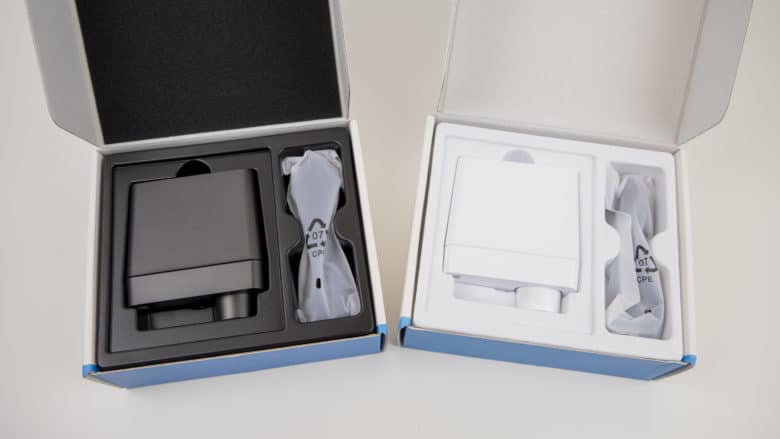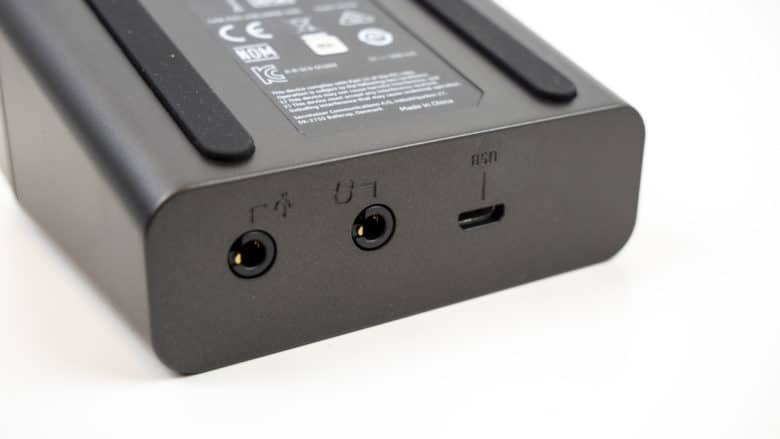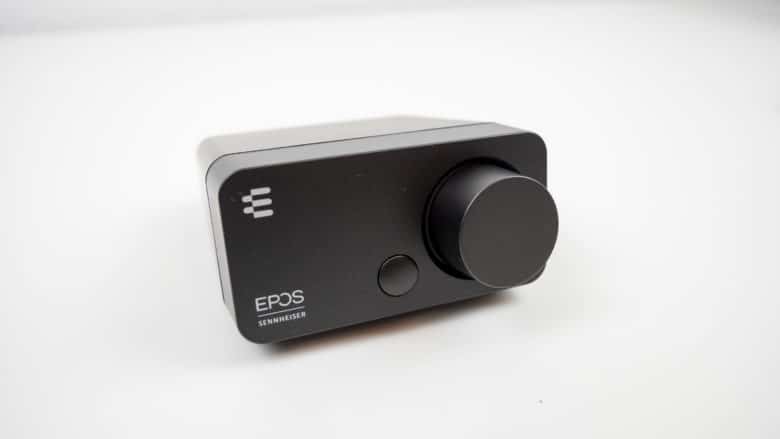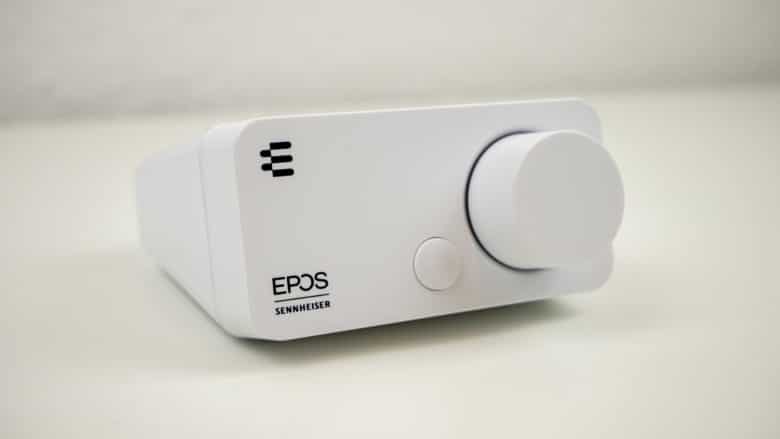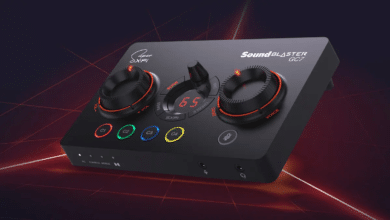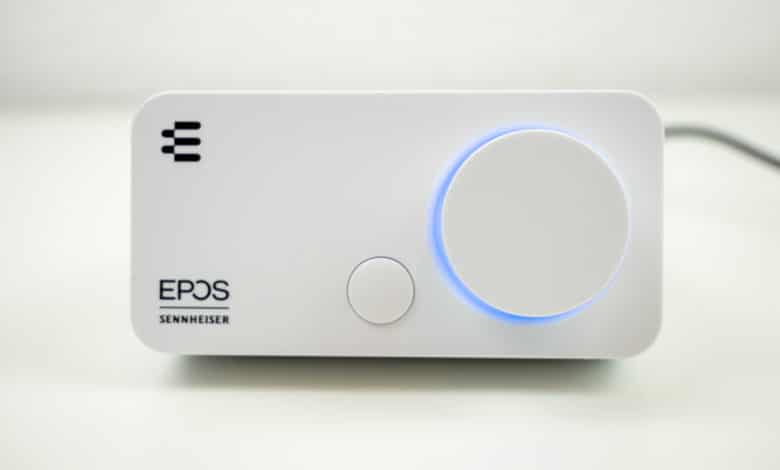
With the EPOS│SENNHEISER GSX 300, the manufacturer EPOS wants to launch a sound card on the market that is supposed to provide sound enjoyment despite its small dimensions. In our test we want to put this small sound card through its paces. Can the EPOS│SENNHEISER GSX 300 convince us and our ears?
The name
The EPOS | SENNHEISER GSX 300 is the little sibling of the successful Sennheiser GSX 1000 series, which is now also part of EPOS. However, this only has to be sacrificed in terms of size. If you take a look at the features of the devices, the small EPOS│SENNHEISER GSX 300 does not have to hide behind its big brothers.
EPOS is an audio and video solutions company that develops and sells devices for businesses and the gaming community. Based on groundbreaking audio technology, the newly founded Danish company EPOS offers high-end audio solutions with contemporary design, advanced technologies and exceptional performance as key drivers.
The establishment of EPOS is based on the decision to continue the business activities of the joint venture between Sennheiser Electronic GmbH & Co KG and Demant A/S – known as Sennheiser Communications – in separate constellations. Parallel to the introduction of a new EPOS brand portfolio, EPOS will take over the distribution of the existing Sennheiser Communications portfolio in the enterprise and gaming sector under the co-branding EPOS | SENNHEISER.
EPOS is part of the Demant Group, a world leader in audio and hearing aid technology. The company builds on more than 115 years of experience in innovation and sound. From its headquarters in Copenhagen, EPOS operates in a global market with subsidiaries and partners in over 30 countries.
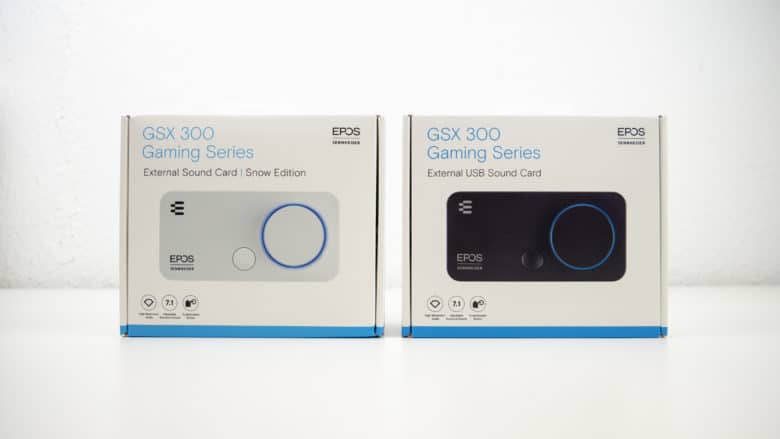
The exterior
At first glance, the EPOS│SENNHEISER GSX 300 makes a very valuable impression. This is not least due to the minimalist design. I like it very much. This applies to both colours. We had both the black and the white version of the small sound card for testing. When you take the little audio friend out of the clearly arranged packaging and put it on the table for the first time, the practical aspect becomes apparent. Sennheiser uses a slightly upward inclination for the sound card. This allows you to operate the EPOS│SENNHEISER GSX 300 optimally.
Especially the conspicuous volume control is easy to reach. Next to the volume control, there is only one more button on the front. The front doesn’t give away more in terms of controls. A similar look awaits us on the back. Aside from an indispensable 3.5 mm jack (input and output for headset), there is also a connection for the power supply. The EPOS│SENNHEISER GSX 300 gets its power from Micro-USB (unfortunately no USB-C). But the USB port also serves as a general connection to the computer.
Technology
The small EPOS│SENNHEISER GSX 300 is anything but a stand-alone amplifier for your headphones. It is rather a genuine sound card. The EPOS│SENNHEISER GSX 300 is used with analogue headphones and headsets that have a jack plug. The aforementioned button next to the volume control has a lot up its sleeve. Since the devices of the 1000 series offer far more buttons on the front, the small sound card seems to be at a disadvantage here. But this is by no means the case. Here the EPOS│SENNHEISER GSX 300 does not have to hide behind its bigger siblings.
Data sheet
| USB-Standard | USB 2.0 |
| Distortion factor (THD) | < 0.01 % |
| Cable length | 1200 mm |
| Dimensions | 91 × 81 × 41 mm |
| Weight | 169 grams |
| Connections | 3.5 mm headset connector, 3.5 mm microphone jack, Micro USB |
| Main audio | 24 Bit 96 kHz (Stereo), 16 Bit 48 kHz (7.1) |
| Compatibility | PC |
| Recommended headphone impedance |
25 – 75 Ω |
| Price | € 54.99 * |

Equalizer
With the EPOS│SENNHEISER GSX 300 you can choose between a stereo mode or a mode with spatial 7.1 sound. You can make detailed sound settings in the equalizer. There are already various presets available here, which you can use very conveniently. But you shouldn’t expect any surprises here. Sennheiser rather focuses on the classics – but that should be enough for most people. But if you miss a special sound, you can easily create your own within the equalizer. You can even make detailed settings such as the reverberation of the room sound. Not only the sound, but also the voice pickup of the microphone can be adjusted. For example, the EPOS│SENNHEISER GSX 300 offers noise suppression and effective voice amplification.
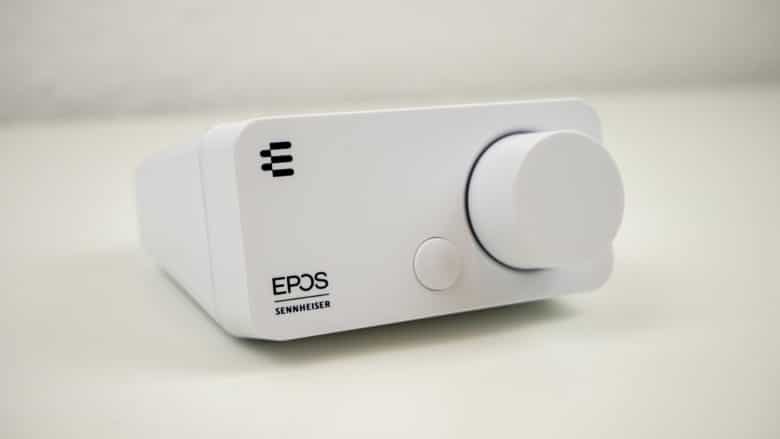
One button – multiple functions
I am admittedly a fan of a surface that is as flat as possible when it comes to technical equipment. Too many buttons can quickly ruin the design. However, functionality must never suffer from this. Sennheiser uses just one more button on the front, next to the volume control. This can be configured as desired. Either you can switch between stereo and 7.1 sound at the touch of a button. Which mode is currently set can be seen from the illuminated ring around the volume control (blue = stereo, red = 7.1). Alternatively, you can switch between the presets at the push of a button.
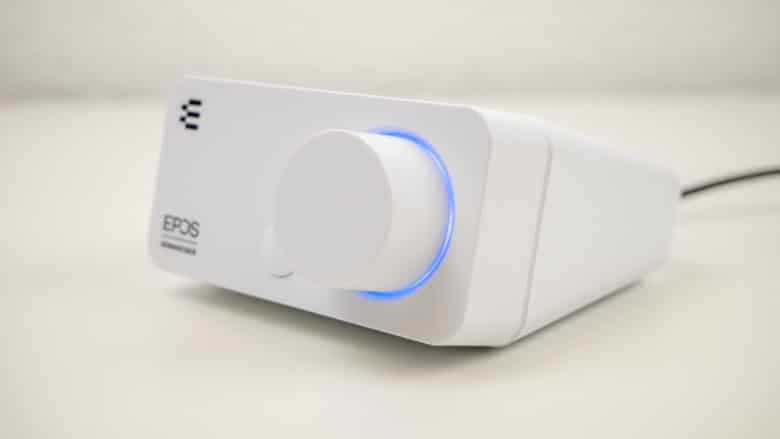
The software
Thanks to the practical and clearly arranged software you can create your own personal presets. It also offers some exciting features and other gadgets around the sound of the small soundcard. But since the software is comparatively clear, you shouldn’t expect miracles here. For average users, however, the setting options should be enough.
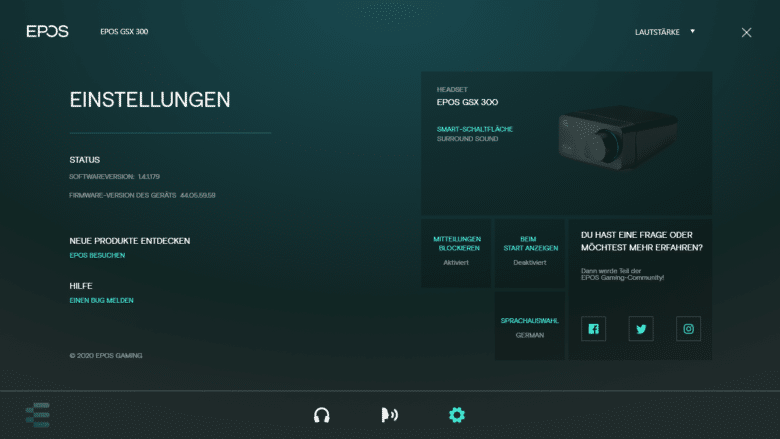
No switching between speaker and headphones
What we have painfully missed is the ability to comfortably switch between the headset and the speakers. This fails simply because the EPOS│SENNHEISER GSX 300 doesn’t have a second output. Unfortunately, the small sound card has to admit defeat to its bigger siblings from the 1000 series. There, the switch function was one of the most exciting and above all most convenient features.
Sound test
Ultimately, a sound card must convince in one discipline above all: sound. It’s no secret that the EPOS│SENNHEISER GSX 300 was tailor-made for gaming. Nevertheless, every gamer would like to be able to enjoy the odd song or two with their PC setup. That’s why I’m testing the EPOS│SENNHEISER GSX 300 in stereo mode first to check its musical capabilities. Then I switch to 7.1 mode and watch how games and movies look like.
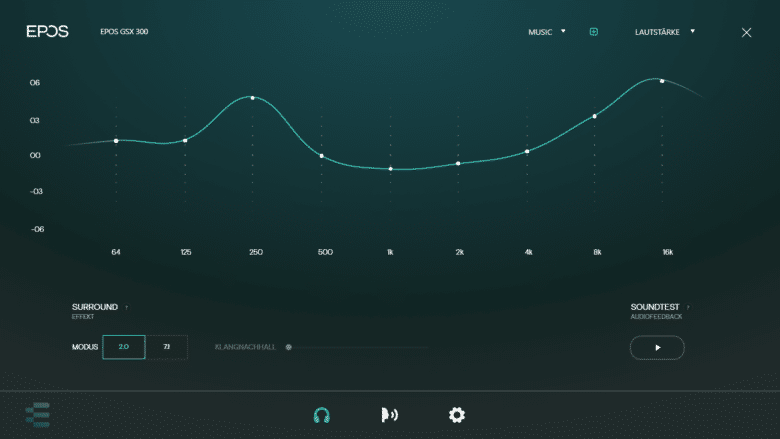
Music
The EPOS│SENNHEISER GSX 300 convinces with music above all with its very neutral sound. As an all-rounder, it reflects almost every genre well in stereo mode. Starting with a rich bass and good mids to pleasant highs, the EPOS│SENNHEISER GSX 300 was able to convince me. I didn’t expect more in this price segment.
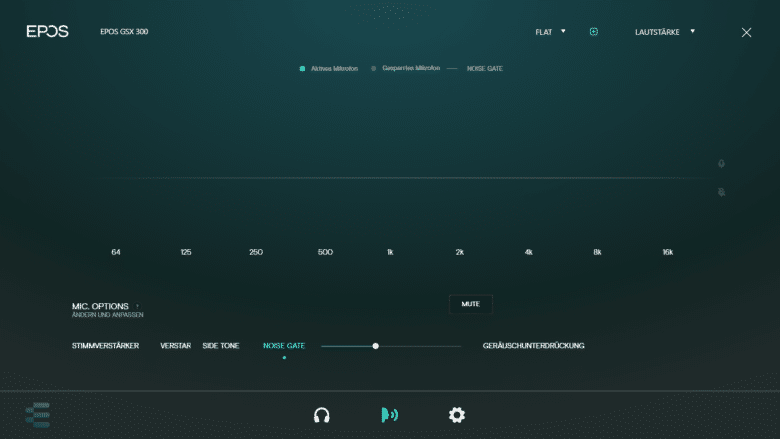
Movies and games
Since the EPOS│SENNHEISER GSX 300 offers a 7.1 mode, I test the audio playback for games and movies with surround sound. At the first sound, the surround sound really convinces me. Although other attributes such as dynamics, precision and resolution are noticeably different in 7.1 mode, this is only disturbing when listening very closely. In a solid action movie you hardly notice these losses. The explosions and car chases get a wide stage through the surround sound, which can be heard. This is where the EPOS│SENNHEISER GSX 300 is really fun. When gaming, the 7.1 mode allows for good enemy location. This could be more accurate, but even this cannot be expected in this price segment.
Must it be surround sound?
The 7.1 mode is definitely an enrichment for every movie and every game. In the end, it’s always a matter of taste, though. Surely the manufacturer could have gotten a lot more out of the EPOS│SENNHEISER GSX 300 here. It remains to be seen whether an update can eradicate the little teething troubles like inaccurate enemy location. After all, everything stands and falls with the resolution of the EPOS│SENNHEISER GSX 300. And with 16/48-bit it is anything but state of the art. Until EPOS makes any improvements here, you should at least stay in stereo mode when listening to music. One must not forget, however, that this is a sound card with an RRP far below 100 Euro. Soundwise, this is therefore grumbling on a high level. If you want more, you have to spend more money.
Conclusion
With the EPOS│SENNHEISER GSX 300, EPOS has definitely achieved its self-imposed goals. The small sound card is very convincing in terms of sound. This applies not only to games, but also to music and films. Thus the EPOS│SENNHEISER GSX 300 is in any case a far better alternative to the bad sound that some motherboards offer. Compared to its big siblings of the 1000 series, the EPOS│SENNHEISER GSX 300 is a bit weak on the chest. This does not concern the extensive features, but the sound itself.
However, the EPOS│SENNHEISER GSX 300 offers two decisive advantages over its bigger siblings. In addition to the lower price, the mini sound card scores above all with its slim dimensions. The pretty sound machine convinces in both elegant white and discreet black and adorns every desk. EPOS has done a really good job here. The nice design also has practical added value. So you can use the EPOS│SENNHEISER GSX 300 really well.
What really bothers me personally are the somewhat limited connection possibilities. If you look around a little bit at the competition, they score in this matter with far more possibilities. Thus, with the EPOS│SENNHEISER GSX 300, you are inevitably confronted with the problem of not being able to easily switch between headset and speakers. But it is precisely because of such features that one acquires a sound card. The EPOS│SENNHEISER GSX 300 is still a rock-solid sound card that does its job very well. Not only does it look damn good, but it also scores with a good sound. However, if you are very demanding in terms of sound, maybe you should look for a more powerful and a little more expensive sound card after all.
EPOS│SENNHEISER GSX 300
Workmanship
Sound quality
Recording quality
Features
Value for money
83/100
With the EPOS│SENNHEISER GSX 300 you get a sound card with good sound, which is my personal candidate for a design award.
